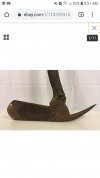At what color heat did the seams start to separate? That's a valuable piece of knowledge.
Very good question.
In theory,one Never forges any welded areas at anything below Welding heat,period,axiomatic.
But Heat is not the whole story either(i DID forge too cold doubtless;with material as nice and compliant as this WI one tends to try to get away with More,and again,raising those very high heats,into yellows,is not easy for me with spruce charcoal).
I'll sound weird for a minute here,please bear with me:Steel is a crystalline lattice(with imperfections et c.,but on the whole).
As such,the manner in which it transmits signal,energy,Vibration,is very important to keep in mind.
(it applies to welds for sure,but also to forging in general:On Can think of forging as squishing about plastic material such as clay,it is partially correct.But the entire picture is closer to a breaking shot in a game of pool:Your hammer-blow imparts an impulse that traverses material,restructuring it).
So simply put it's Harmonics,and steel is super sensitive to it,it really being the very nature of forging.
Welds in particular are Super vulnerable,early on,when they're fresh,those molecules are exchanging their electrons,swapping them about.Steel is fairly active at room T,diffusion continues at anything above zero Kelvin,(what is it,-200-some F?)
In practical terms what it all means is that a forging loves a Definite,Decisive blows,as hard as possible,and as few of them.
In and out,high T,tons of energy applied in a strictly right direction,and leave it Be!!!

So when i get to pecking about in the finishing stages,vibration,bouncing,all those less-than-confident,exploratory blows,it damages the laminate.
That is why what we do here together is so important-we're trying to re-establish the sequence,the shortest,most no-nonsense path to the desired shape.
Smiths of old did not fluff about(in part because of all that,they knew it perfectly well,felt it with their hammers).
The central chunk of poll is another kind of WI,and i've a couple curious photos on that subject,if Imgur's willing..
But it's true that the strongest welds are between dissimilar parts,it would've been wiser to use something else.







